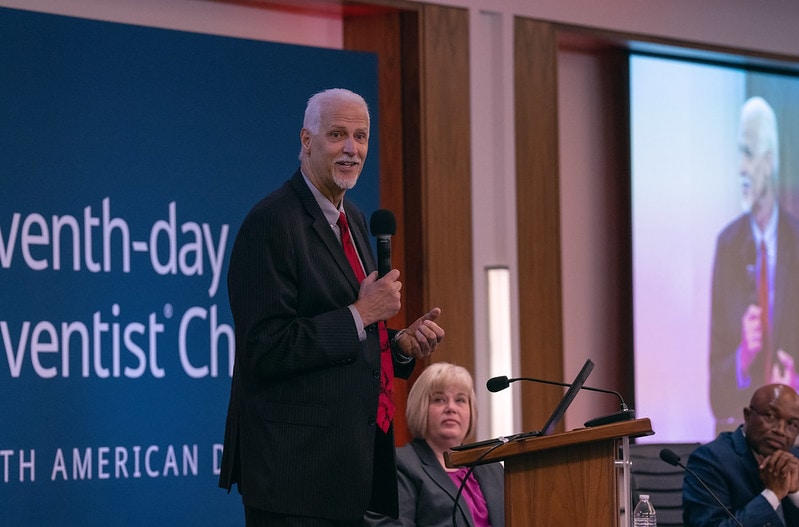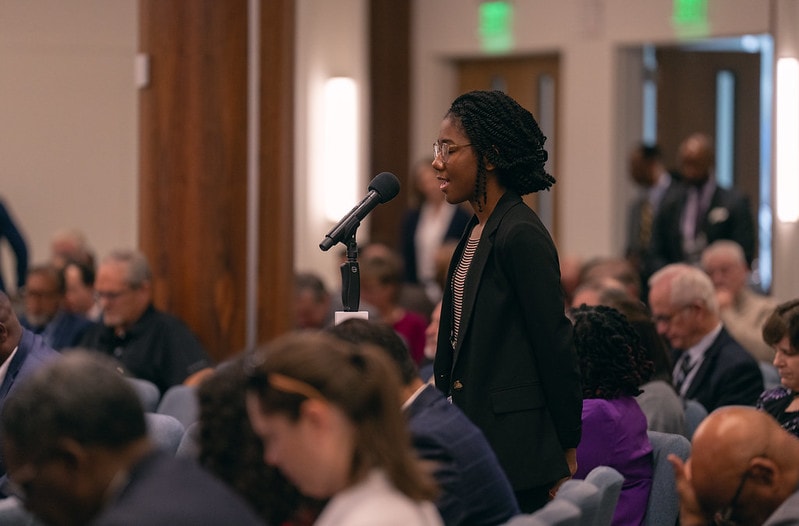
Where are we going as the North American Division (NAD) of the Seventh-day Adventist Church? And how are our resources allocated in order to reach those goals? These were the broad focus areas on the second day of the 2023 NAD Year-End Meeting in Columbia, Maryland, United States, themed “Together in Mission: I Will Go.”
“God has called us to lead, with an assignment to serve in a very interesting time in history,” said G. Alexander Bryant, NAD president, as he began his president’s report on October 27. He continued by asking all the attendees to ponder “what God is calling us to do at this moment.” His emphasis on exploring ways we can better and more effectively collaborate since “we are more effective, more powerful, more impactful on those things when we can do them together,” echoed across the morning’s other main agenda items.
The first was an in-depth presentation from recently retired NAD treasurer Randolph Robinson on how tithe is distributed within the church. The second was a series of reports from three special committees that followed up on the three challenging breakout topics from the 2022 session: (1) Education; (2) Online Churches; and (3) Membership Data.
Robinson drew on his many years of experience, both as NAD treasurer and as a conference treasurer, to present a comprehensive, easy-to-understand picture of how tithe funds move within the Adventist Church between the conference, union, and finally the division. His passionate belief that “our ability to do things together, is our key to success” permeated each section of his presentation.
Robinson laid out a basic pie chart depiction of the allocations, showing approximately 65 percent of the funds remaining with the local conference, 14 percent going to the NAD and General Conference (GC), 9 percent to the union, 11 percent to the retirement fund, and just under 1 percent to the special assistance fund. Robinson spent most of his remaining time showing all the ways that large portions of that money still return to the local conference and church level. This might be in the form of appropriations from the special assistance fund, which helps conferences with less resources, or through services provided such as comprehensive insurance or school curriculum development that would be much more expensive, if not impossible, for an individual conference or church to attain.
“These appropriations and expenditures occur because of the following principles that have been a part of the church structure for a very long time,” Robinson said. “Number one is the more financially able helping the less financially able, and number two is focusing on the ability to target resources to large areas of need churchwide.”
It was a topic that seemed to touch the work of every person attending these meetings and at the close many delegates stood to add their own comments to the discussion. Most focused on the importance of getting this information out to the lay members of the church, especially the younger generations who do not inherently support institutions as readily as their elders did, encouraging the division to share this information beyond the current plans to publish it in the December 2023 edition of Adventist Journey. Others noted that the highest percentage of increases in cost occur at the conference level and dealing with that needs to be addressed regardless of the value of the combined services that conferences receive.
Bryant closed the session by saying, “I asked Elder Robinson to make this presentation … because [we need to] understand what we have, how it is divided and then we need to make some decisions. What we have is a tremendous thing; and how can we ensure that it continues to be a tremendous thing going forward?”


The delegates rose to their feet in recognition of Robinson and his wife, Denise, for their 41 years of service across the division. Bryant presented Robinson with the President’s Award for Faithful and Committed Service. “Thank you for your faithfulness and also your friendship and relationship through the years,” Bryant said. (Robinson retired this past July and he and his wife will soon be moving to Florida.)
At the 2022 Year-End Meetings it was decided that certain issues were so important and multifaceted that they merited deep thought and broad discussion. They included (1) Education: How can we recruit and retain more teachers? (2) Online Church: How do we want to respond and engage? And (3) Membership Data: How can we more effectively use the data we have?
A significant amount of time in 2022 was spent in breakout sessions with groups of delegates putting together an initial list of ideas. The administration followed up on that work by assigning a committee for each topic with the task of refining those ideas into specific actionable steps. The work of the various committees was brought to the 2023 Year-End Meeting, which concluded with breakout sessions for further discussion in the last session of the business day. A more in-depth report on these topics is expected soon.
Early in the day delegates approved candidates brought forward by the nominating committee for three positions. Ivan L. Williams, Sr. is the new vice president for strategy and leadership, having previously served as the NAD Ministerial Association director for the past 12 years. Adam Fenner, the director of NAD’s Adventist Learning Community, is now also the new NAD vice president for digital media. And the vacancy of NAD under-treasurer that was created when Judy Glass became the NAD treasurer a few months ago will now be filled by Chad Grundy of the Carolina Conference. Grundy brings with him a history of more than 30 years of conference-level experience, leaders said.
The original version of this story was posted on the North American Division news site.